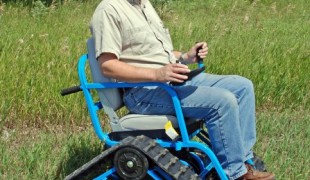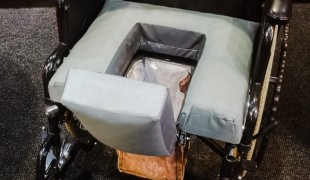- 5081
- 424
- 5
- 11
- 0
- Help Ukraine
About the solution
“My grandparents are over 80 years old, and they live in a seven story building without elevator in Chongqing, a mountainous city. Having weak feet and legs, getting inside and outside the building is very inconvenient”, said Yutian Wang, a 10th grade student from Beijing Industrial University affiliated middle school. In addition, elder people may easily fall when climbing the stairs, which can even lead to irreversible consequences.
Yutian would like to contribute more to improve his grandparents' quality of life. Since middle school, he started to notice the barrier-free facilities at the subway station and was thinking of developing a wheelchair that would be capable of climbing the stairs to replace walking. “The commercial products are usually very expensive and lack the shock absorptions and other safety measurements”, the inventor explained.
With reference to the movement of tanks, Yutian Wang has developed a “stair-climbing” wheelchair with a self-balancing function. He fitted the wheelchair with an electronic gyroscope and an accelerometer, being able to provide real-time monitoring of the angle between the chair and the ground. Once the angle changes, the system will control the two-axis balancing system under the wheelchair seat to adjust and ensure the seat is flat (when the stair slope is less than 30 degrees) or close to flat (when the star slope is between 30 and 45 degrees). He also included a shock absorption system and an automatic protection system, which consistently evaluates the environment and fixes the wheelchair on the stairs in case of unexpected movements.
Wang’s stair-climbing wheelchair prototype has won several awards in innovation contests. He was constantly improving the wheelchair during his busy study and already developed the device’s 5th generation. “However, those are not enough. In the next generation I believe it would be necessary to include GPS location and alarm system for normal and emergency situations, and also auto-driving, similar to the elevator, you just press the button and it will take you to the certain floor”.
Wang believes that his invention can be promoted and included in the field of community-based elderly care system, and become a public facility that could serve more seniors and disabled people.
Adapted from: http://bit.ly/2EY6pox
This solution shall not include mention to the use of drugs, chemicals or biologicals (including food); invasive devices; offensive, commercial or inherently dangerous content. This solution was not medically validated. Proceed with caution! If you have any doubts, please consult with a health professional.
DISCLAIMER: This story was written by someone who is not the author of the solution, therefore please be advised that, although it was written with the utmost respect for the innovation and the innovator, there can be some incorrect statements. If you find any errors please contact the patient Innovation team via info@patient-innovation.com
-
-
415
-
0
-
4449
Home solutions for disabled people
MOVING IN A WHEELCHAIR: Moving using a wheelchair.
Neuromuscular Disorders
Cervical spinal cord injury/Tetraplegia
Assistive Daily Life Device (to help ADL)
Walking Aid (wheelchair/walker/crutches)
Gait abnormalities (e.g., walking difficulties, unsteady gait)
Muscle cramps or spasms
Difficulty coordinating movements
Stiffness or rigidity (difficulty moving)
Paralysis of the legs and lower body
Muscle weakness
Loss of balance
Cognitive impairment
Anxiety
Promoting self-management
Maintaining Balance and Mobility
Preventing (Vaccination, Protection, Falls, Research/Mapping)
Neurology
Orthopedics
Rheumatology
United Kingdom
-
-
-
417
-
0
-
6291

Parents create a track-chair for their paralysed son
MOVING IN A WHEELCHAIR: Moving using a wheelchair.
CAREGIVING
Paralysis
Neuromuscular Disorders
Walking Aid (wheelchair/walker/crutches)
Assistive Daily Life Device (to help ADL)
Gait abnormalities (e.g., walking difficulties, unsteady gait)
Difficulty coordinating movements
Stiffness or rigidity (difficulty moving)
Paralysis of the legs and lower body
Muscle weakness
Loss of balance
Promoting inclusivity and social integration
Maintaining Balance and Mobility
Preventing (Vaccination, Protection, Falls, Research/Mapping)
Caregiving Support
Neurology
Neurosurgery
Orthopedics
Rheumatology
United States
-
-
-
373
-
0
-
3925

The PARA-TUBE
(SELF)-CARE: USING THE TOILET: Using the toilet independently
MOVING IN A WHEELCHAIR: Moving using a wheelchair.
Bone Disorders (Decalcification, Bone Deformity, Bone Fracture, Bone Infection)
Spinal Cord and Nerve Root Disorders
Walking Aid (wheelchair/walker/crutches)
Assistive Daily Life Device (to help ADL)
Difficulty walking or moving
Gait abnormalities (e.g., walking difficulties, unsteady gait)
Difficulty coordinating movements
Stiffness or rigidity (difficulty moving)
Paralysis of the legs and lower body
Muscle weakness
Limited range of motion
Muscle pain or stiffness
Muscle cramps or spasms
Promoting self-management
Maintaining Balance and Mobility
Preventing (Vaccination, Protection, Falls, Research/Mapping)
Neurology
Orthopedics
Physical Medicine and Rehabilitation
Rheumatology
South Africa
-

 en
en